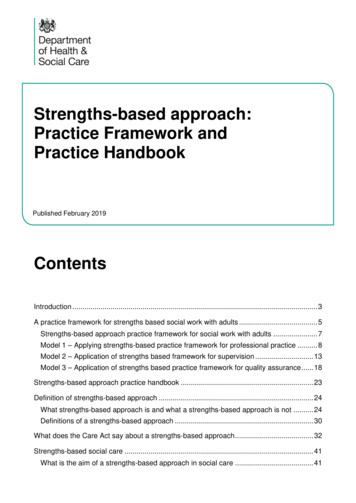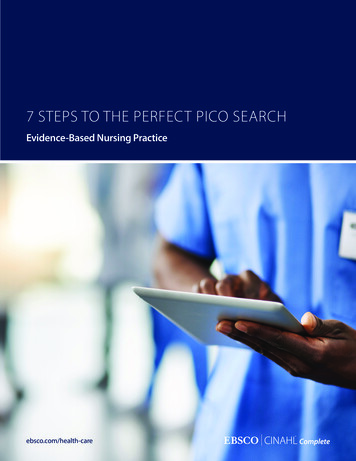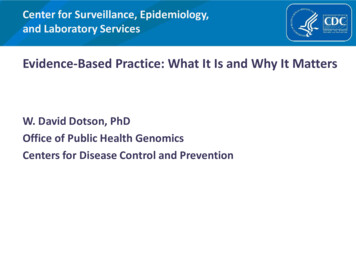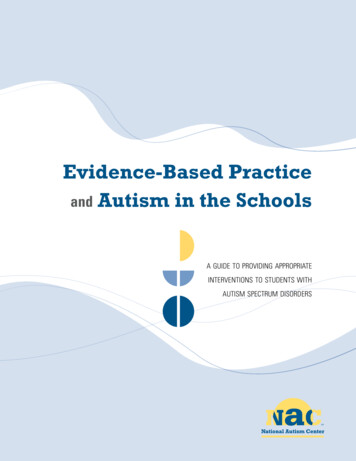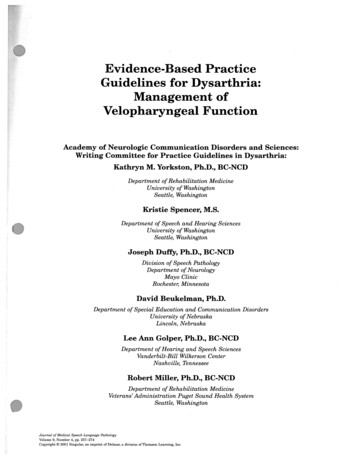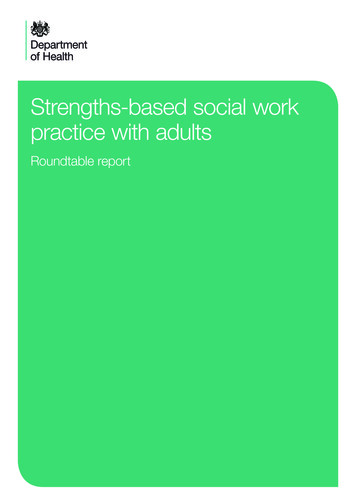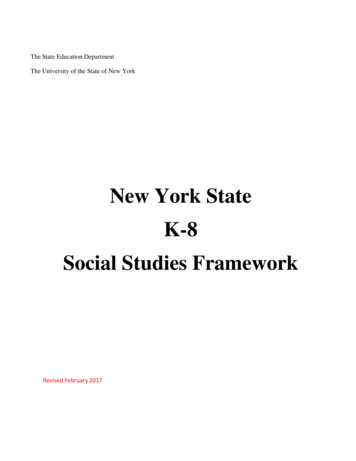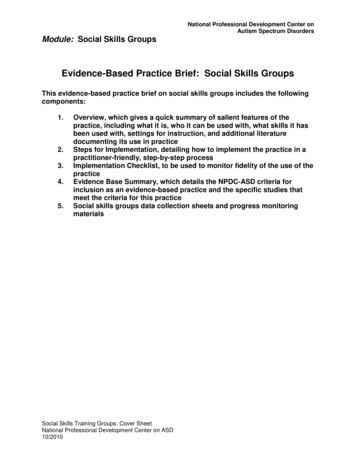
Transcription
National Professional Development Center onAutism Spectrum DisordersModule: Social Skills GroupsEvidence-Based Practice Brief: Social Skills GroupsThis evidence-based practice brief on social skills groups includes the followingcomponents:1.2.3.4.5.Overview, which gives a quick summary of salient features of thepractice, including what it is, who it can be used with, what skills it hasbeen used with, settings for instruction, and additional literaturedocumenting its use in practiceSteps for Implementation, detailing how to implement the practice in apractitioner-friendly, step-by-step processImplementation Checklist, to be used to monitor fidelity of the use of thepracticeEvidence Base Summary, which details the NPDC-ASD criteria forinclusion as an evidence-based practice and the specific studies thatmeet the criteria for this practiceSocial skills groups data collection sheets and progress monitoringmaterialsSocial Skills Training Groups: Cover SheetNational Professional Development Center on ASD10/2010
National Professional Development Center onAutism Spectrum DisordersModule:Social Skills GroupsOverview of Social Skills GroupsCollet-Klingenberg, L. (2009). Overview of social skills groups. Madison, WI: The NationalProfessional Development Center on Autism Spectrum Disorders, Waisman Center,University of Wisconsin.Social skills groups are used to teach individuals with autism spectrum disorders (ASD) ways toappropriately interact with typically developing peers. Social skills groups typically involve smallgroups of two to eight individuals with disabilities and a teacher or adult facilitator. Most socialskill group meetings include instruction, role-playing or practice, and feedback to help learnerswith ASD acquire and practice skills to promote positive social interactions with peers.EvidenceThis practice meets evidence-based criteria with six studies (two group; four single-subjectdesign) in the social domain across preschool, elementary, and secondary age ranges.With what ages are social skills groups effective?Within the evidence-base, studies included learners as young as 4 and as old as 12 years ofage. Thus, social skills groups have the potential to be an effective practice with all learners.Research also exists that supports its use with adult learners.What skills or intervention goals can be addressed with social skills groups?In the evidence base, social skills group training targeted the following: perspective-taking,conversation skills, friendship skills, problem-solving, social competence, emotion recognition,theory of mind, and problem-solving. In addition, specific interaction skills such as initiation,responding, maintaining, greeting, giving/accepting compliments, turn taking, sharing, asking forhelp, offering help, and including others were also improved through the use of social skillsgroups.In what settings can social skills groups be effectively used?In the evidence base, training took place in a variety of school and clinic settings and includedboth inclusive and non-inclusive settings.Evidence BaseThe studies cited in this section provide the basis upon which this practice was determined tomeet the NPDC on ASD’s criteria as an evidence-based practice. This list is not exhaustive;other quality studies may exist that were not included.Social Skills Training Groups: OverviewNational Professional Development Center on ASD10/2010Page 1 of 3
National Professional Development Center onAutism Spectrum DisordersModule:Social Skills GroupsPreschoolKroeger, K. A., Schultz, J. R., & Newsom, C. (2007). A comparison of two group-delivered socialskills programs for young children with autism. Journal of Autism and DevelopmentalDisorders, 37(5), 808-817.ElementaryBock, M. A. (2007). The impact of social-behavioral learning strategy training on the socialinteraction skills of four students with Asperger syndrome. Focus on Autism and OtherDevelopmental Disorders, 22(2), 88-95.Feng, H., Lo, Y., Tsai, S., & Cartledge, G. (2008). The effects of theory-of-mind and social skillstraining on the competence of a sixth-grade student with autism. Journal of PositiveBehavior Intervention, 10, 228-242.Kamps, D. M., Leonard, B. R., Vernon, S., Dugan, E. P., Delquadri, J. C., Gerson, B., Wade, L.,& Folk, L. (1992). Teaching social skills to students with autism to increase peerinteractions in an integrated first-grade classroom. Journal of Applied Behavior Analysis,25(2), 281-288.Kroeger, K. A., Schultz, J. R., & Newsom, C. (2007). A comparison of two group-delivered socialskills programs for young children with autism. Journal of Autism and DevelopmentalDisorders, 37(5), 808-817.Licciardello, C. C., Harchik, A. E., & Luiselli, J. K. (2008). Social skills intervention for childrenwith autism during interactive play at a public elementary school. Education andTreatment of Children, 31, 28-37.Solomon, M., Goodlin-Jones, B., & Anders, T. F. (2004). A social adjustment enhancementintervention for high functioning autism, Asperger’s syndrome, and pervasivedevelopmental disorder NOS. Journal of Autism and Developmental Disorders, 34, 649668.SecondarySolomon, M., Goodlin-Jones, B., & Anders, T. F. (2004). A social adjustment enhancementintervention for high functioning autism, Asperger’s syndrome, and pervasivedevelopmental disorder NOS. Journal of Autism and Developmental Disorders, 34, 649668.Selected Additional ReferencesBauminger, N. (2007). Brief report: Individual social-multi-modal intervention for HFASD.Journal of Autism and Developmental Disorders, 37, 1593-1604.Social Skills Training Groups: OverviewNational Professional Development Center on ASD10/2010Page 2 of 3
National Professional Development Center onAutism Spectrum DisordersModule:Social Skills GroupsBauminger, N. (2002). The facilitation of social-emotional understanding and social interaction inhigh-functioning children with autism: Intervention outcomes. Journal of Autism andDevelopmental Disorders, 32(4), 283-298.Hillier, A., Fish, T., Cloppert, P., & Beversdorf, D. Q. (2007). Outcomes of a social andvocational support group for adolescents and young adults on the autism spectrum.Focus on Autism and Other Developmental Disabilities, 22(2), 107-115.Howlin, P., & Yates, P. (1999). The potential effectiveness of social skills groups for adults withautism. Autism, 3(3), 299-307.Mackay, T., Knott, F., & Dunlop, A. W. (2007). Developing social interaction and understandingin individuals with autism spectrum disorder: A groupwork intervention. Journal ofIntellectual and Developmental Disability, 32(4), 279-290.Matson, J. L., Matson, M. L., & Rivet, T. T. (2007). Social-skills treatments for children withautism spectrum disorders: An overview. Behavior Modification, 31(5), 682-707.Mesibov, G. B. (1984). Social skills training with verbal autistic adolescents and adults: Aprogram model. Journal of Autism and Developmental Disorders, 14(4), 395-404.Ozonoff, S., & Miller, J. N. (1995). Teaching theory of mind: A new approach to social skillstraining for individuals with autism. Journal of Autism and Developmental Disorders,25(4), 415-433.Tse, J., Strulovitch, J., Tagalakis, V., Meng, L., & Fombonne, E. (2007). Social skills training foradolescents with Asperger syndrome and high-functioning autism. Journal of Autism andDevelopmental Disorders, 37(10), 1960-1968.White, S. W., Koenig, K., & Scahill, L. (2007). Social skills development in children with autismspectrum disorders: A review of the intervention research. Journal of Autism andDevelopmental Disorders, 37, 1858-1868.Williams, T. I. (1989). A social skills group for autistic children. Journal of Autism andDevelopmental Disorders, 19(1), 143-155.Social Skills Training Groups: OverviewNational Professional Development Center on ASD10/2010Page 3 of 3
National Professional Development Center onAutism Spectrum DisordersModule: Social Skills GroupsEvidence Base for Social Skills GroupsThe National Professional Development Center on ASD has adopted the following definition ofevidence-based practices.To be considered an evidence-based practice for individuals with ASD, efficacy must beestablished through peer-reviewed research in scientific journals using:randomized or quasi-experimental design studies. Two high quality experimental orquasi-experimental group design studies,single-subject design studies. Three different investigators or research groups musthave conducted five high quality single subject design studies, orcombination of evidence. One high quality randomized or quasi-experimental groupdesign study and three high quality single subject design studies conducted by atleast three different investigators or research groups (across the group and singlesubject design studies).High quality randomized or quasi experimental design studies do not have critical design flawsthat create confounds to the studies, and design features allow readers/consumers to rule outcompeting hypotheses for study findings. High quality in single subject design studies isreflected by a) the absence of critical design flaws that create confounds and b) thedemonstration of experimental control at least three times in each study.This definition and criteria are based on the following sources:Horner, R., Carr, E., Halle, J., McGee, G., Odom, S., & Wolery, M. (2005). The use of singlesubject research to identify evidence-based practice in special education. ExceptionalChildren, 71, 165-180.Nathan, P., & Gorman, J. M. (2002). A guide to treatments that work. NY: OxfordUniversity Press.Odom, S. L., Brantlinger, E., Gersten, R., Horner, R. D., Thompson, B., & Harris, K. (2004).Quality indicators for research in special education and guidelines for evidence-basedpractices: Executive summary. Arlington, VA: Council for Exceptional Children Divisionfor Research.Rogers, S. J., & Vismara, L.A. (2008). Evidence-based comprehensive treatments for earlyautism. Journal of Clinical Child and Adolescent Psychology, 37(1), 8-38.Using these criteria, the empirical studies referenced below provide documentation forsupporting the use of social skills training groups as an evidence-based practice for childrenwith ASD. This list is not exhaustive; other quality studies may exist that were not included.Social Skills Training Groups: Evidence BaseNational Professional Development Center on ASD10/2010Page 1 of 2
National Professional Development Center onAutism Spectrum DisordersModule: Social Skills GroupsPreschoolKroeger, K. A., Schultz, J. R., & Newsom, C. (2007). A comparison of two group-delivered socialskills programs for young children with autism. Journal of Autism and DevelopmentalDisorders, 37(5), 808-817.ElementaryBock, M. A. (2007). The impact of social-behavioral learning strategy training on the socialinteraction skills of four students with Asperger syndrome. Focus on Autism and OtherDevelopmental Disorders, 22(2), 88-95.Feng, H., Lo, Y., Tsai, S., & Cartledge, G. (2008). The effects of theory-of-mind and social skillstraining on the competence of a sixth-grade student with autism. Journal of PositiveBehavior Intervention, 10, 228-242.Kamps, D. M., Leonard, B. R., Vernon, S., Dugan, E. P., Delquadri, J. C., Gerson, B., Wade, L.,& Folk, L. (1992). Teaching social skills to students with autism to increase peerinteractions in an integrated first-grade classroom. Journal of Applied Behavior Analysis,25(2), 281-288.Kroeger, K. A., Schultz, J. R., & Newsom, C. (2007). A comparison of two group-delivered socialskills programs for young children with autism. Journal of Autism & DevelopmentalDisorders, 37(5), 808-817.Licciardello, C. C., Harchik, A. E., & Luiselli, J. K. (2008). Social skills intervention for childrenwith autism during interactive play at a public elementary school. Education andTreatment of Children, 31, 28-37.Solomon, M., Goodlin-Jones, B., & Anders, T. F. (2004). A social adjustment enhancementintervention for high functioning autism, Asperger’s syndrome, and pervasivedevelopmental disorder NOS. Journal of Autism and Developmental Disorders, 34, 649668.SecondarySolomon, M., Goodlin-Jones, B., & Anders, T. F. (2004). A social adjustment enhancementintervention for high functioning autism, Asperger’s syndrome, and pervasivedevelopmental disorder NOS. Journal of Autism and Developmental Disorders, 34, 649668.Social Skills Training Groups: Evidence BaseNational Professional Development Center on ASD10/2010Page 2 of 2
National Professional Development Center onAutism Spectrum DisordersModule: Social Skills GroupsSteps for Implementation: Social Skills GroupsCollet-Klingenberg, L. (2009). Steps for implementation: Social skills groups. Madison, WI: TheNational Professional Development Center on Autism Spectrum Disorders, WaismanCenter, University of Wisconsin.Social skills groups may be used to teach a variety of social behaviors. In the evidence base,social skills group training targeted perspective-taking, conversation skills, friendship skills,problem-solving, social competence, emotion recognition, theory of mind, and problem-solving.In addition, specific interaction skills such as initiation, responding, maintaining, greeting,giving/accepting compliments, turn taking, sharing, asking for help, offering help, and includingothers were also improved through the use of social skills groups. The researchers whoprovided the evidence base for this practice approached group instruction in various ways, butall included several common components, outlined in the steps that follow. Most publishedsocial skills group curricula provide guidelines or implementation steps specific to the programthat should be followed. The following steps are designed to help teachers/practitioners useexisting resources to implement social skills group instruction that is based on informal needsassessment and data collection and on individual IEP/IFSP goals.Step 1. Identifying Social Skills Targeted for Instruction1. Teachers/practitioners refer to the IEP/IFSP to identify relevant goals for individuallearners with ASD.Often when the decision is made to implement social skills group instruction, skill deficits orsocial goals have already been identified for two or more learners with ASD. Beforeimplementing social skills training groups, teachers/practitioners objectively define the targetbehaviors or skills that will be the focus of the intervention based on learners‟ IEP or IFSP goals.2. Teachers/practitioners discuss goals with the IEP/IFSP team, including family membersand learners.Teachers/practitioners talk with the learners and with those who know the learners to determinehow group skills could be targeted during instruction. For example, one learner may havetrouble initiating verbal interactions with others. Another may have no trouble initiating, butusually does so in a way that alienates others (e.g., runs toward them yelling). A third mayinitiate, but does not wait for a response before moving on to someone else. Many socialbehaviors can be grouped for instruction. Conversation skills, for example, are made up ofsmaller skills or behaviors such as initiating, turn-taking, and terminating interactions. Learnerswith different skill levels and needs can be placed in the same group where they can model andpractice the skills that they have, while at the same time learning new skills.3. Teachers/practitioners ensure that the target of instruction is observable andmeasurable.Social Skills Training Groups: Steps for ImplementationNational Professional Development Center on ASD10/2010Page 1 of 15
National Professional Development Center onAutism Spectrum DisordersModule: Social Skills GroupsOnce relevant goals have been identified, and the goals of multiple learners have been groupedfor instruction, teachers/practitioners write goals for the target behavior/skill that are observableand measurable. Using the example of conversation skills, it is not enough to write the goalsimply as, “Joe, Tom, and Matt will improve their conversation skills.” While those who know theboys well will have a general understanding of the goal, it does not provide enough detail forcollecting reliable data or providing systematic instruction. A specific goal that becomes moreeasily observed and measured might be, “Joe, Tom, and Matt will improve their conversationskills in the following ways: Joe will increase conversational initiations by 50%; Tom will initiateinteractions with others using a calm voice and will stand still or sit during interactions; and Mattwill wait for a count of ten, allowing his partner an opportunity to respond, before initiating asecond time or with another person.”Step 2. Organizing Training Groups1. Teachers/practitioners identify group members with similar goals.Unlike peer-mediated instruction and intervention (please refer to the PMII resourcesdeveloped by the National Professional Development Center on ASD atwww.autisminternetmodules.org), social skills groups are typically made up only of learnerswith ASD or other disabilities. Though it may be tempting to include typically developing learnerswith limited social skills, the evidence base for this practice was based on learners with ASD.Students with ASD have unique social and communication characteristics that are often notevident in learners with other disabilities.2. Teachers/practitioners select adults/helpers who have experience with ASD or who havereceived professional development about the needs of learners with ASD.When selecting adult leaders or group facilitators, teachers/practitioners should be careful toemploy only those who are familiar with the learners and/or have had experience working withlearners with ASD. Group leaders may include teachers, psychologists, speech-languagepathologists, educational assistants, parents, or others who have previously worked with someor all of the learners. Many high schools, however, use upper classmen to tutor or otherwisesupport younger learners (with and without disabilities). This is an acceptable alternative ifqualified adults are not available to assist with social skills group instruction. If peers assist withsocial groups, they should be given an overview of ASD and introduced to the learners in thesocial skills group (with parental permission, of course) prior to beginning the group instruction.This introduction to ASD and to the students in the social skills group will provide an opportunityfor any questions or concerns to be addressed prior to beginning training.3. Teachers/practitioners organize groups that contain no more than three or four learnersper adult/helper.Ideally, one leader or assistant for every three learners should be involved in training.Depending on the needs and characteristics of the learners, more or fewer helpers may beappropriate. In the evidence-based studies, groups ranged from three to nine members, withmost having four per group.Social Skills Training Groups: Steps for ImplementationNational Professional Development Center on ASD10/2010Page 2 of 15
National Professional Development Center onAutism Spectrum DisordersModule: Social Skills GroupsStep 3. Collecting Baseline Data1. Teachers/practitioners create data sheets using group members‟ individual targetbehaviors and goals.Data sheets may vary by individual, or one data sheet that captures all students‟ target skillsmay be developed. For example, if the individuals participating in the social skills group areeach working on different aspects of conversational skills, teachers/practitioners could design adata sheet that reflects all aspects of conversation (e.g., initiations, turn-taking, terminations,asking leading or follow-up questions, responding to others‟ initiations). On this same datasheet, teachers/practitioners could then collect data for individual learners that focus only on thespecific skill that they are working on. (See sample data sheets attached to this document.)2. Teachers/practitioners record data for each group member on the data sheet(s).3. Teachers/practitioners collect, summarize, and graph sufficient data to identify learners‟current use of skills.Once baseline data have been collected for a sufficient amount of time (e.g., on at least threeoccasions), data should be summarized or graphed to document learners‟ current use of targetskills and to provide a starting point for tracking learner progress.Step 4. Scheduling Group Meetings1. Teachers/practitioners select a time and place for holding training meetings that ismutually convenient and optimal for both learners and helpers.Once the learners have been identified for social skills group instruction, and the adults who willlead and assist the group have been recruited, it is time to determine when the group trainingwill take place. Social skill group training may occur during the regular instructional day, beforeor after school, during a lunch or recess/break time, or even on a weekend. When selecting thetime for the training, consider the schedules of leaders and learners, as well as thecharacteristics of learners. For example, if missing the regularly scheduled lunch or recess islikely to lead to interfering behavior (e.g., increased stereotypic behaviors or aggression), thenavoid scheduling a group session at that time. Similarly, if a learner is known to have troublegetting started in the morning, including him in an early morning social skills group may notresult in the desired outcome.2. Teachers/practitioners establish sufficient time for teaching, but not so long that learnersbecome overwhelmed or lose interest.The studies in the evidence base included training meetings that lasted from 10 to 90 minutesand included time for a warm up, instructional time, practice time, feedback, and ended with asnack or free time to reward those involved (as well as provide a safe setting for continuedpractice of the skills being learned).Social Skills Training Groups: Steps for ImplementationNational Professional Development Center on ASD10/2010Page 3 of 15
National Professional Development Center onAutism Spectrum DisordersModule: Social Skills GroupsThe number of training sessions and how often each group meets will vary by the topic or targetof instruction and by how quickly progress is made in learning the skills. In the evidence-basedstudies, social skills training groups were implemented for a minimum of 12 sessions; however,some trainings lasted for as many as 20 sessions. Many of the groups in the studies met threeor four times each week.3. Teachers/practitioners consider the ages, developmental level of learners, and thecontext of instruction when scheduling group meetings.The length of the session should reflect the ages and developmental levels of learners as wellas the context of instruction. For instance, younger learners will generally have shortersessions. Also sessions that focus on pre-teaching (or advance shadowing) before a socialcontext, such as prompting social behaviors before going to recess or lunch, may be shorterthan those that include a longer practice time within the context of group instruction.Step 5. Creating a Training Format or Structure1. Teachers/practitioners clearly identify a format with set beginning/ending times and timefor various activities.2. Teachers/practitioners insure that the format includes at least an introduction,instruction, practice, and feedback with reinforcement.Social skills training group sessions should be carefully formatted to clearly identifydate/schedules for the sessions, the purpose of the session, the members of the group,expectations for the session, beginning and ending times, and the location of the sessions. Forsome learners, a visual schedule of events should ease anxiety about the group.3. Teachers/practitioners select a format appropriate for the age and characteristics of thelearners in the group.To make the best use of time set aside for social skills training groups, it is especially importantto have a carefully planned format for the session. If the format is planned and adhered to,learners will be more likely to successfully acquire the targeted skills. In addition, both learnersand leaders/helpers will enjoy the sessions and want to continue participating. The formatchosen may vary according to the types of skills being taught, the setting for instruction, and thetime allotted for the session. In the evidence base studies, most social skills groups used aformat that included an opening and closing time with instruction and practice time embedded inthe middle. A general format may include the following components:a. introduction/warm-up. In this phase, everyone settles into the group time.Introductions are made initially, but may need to be repeated for at least the first fewsessions if group members do not already know one another. Having both leadersand learners sit in a circle and take turns introducing themselves was often usedduring this introductory/warm-up time. (Some facilitators ask learners to pass anobject, such as a small rubber ball, from person to person as they share.) Atsubsequent meetings, participants can be asked to introduce one another, ifSocial Skills Training Groups: Steps for ImplementationNational Professional Development Center on ASD10/2010Page 4 of 15
National Professional Development Center onAutism Spectrum DisordersModule: Social Skills Groupsappropriate. After group members become familiar with one another, thisintroductory/warm-up time may be used to discuss experiences in using the targetsocial skills from the previous week (or the time between meetings, if it is not aweekly group time).b. topic focus. The group leader will introduce the topic or focus of instruction for thesession. This component of the session may also be a good time to review skills thatwere previously learned and to ask if anyone has questions or concerns. As groupmembers become more comfortable with one another and the format, individuals cantake turns reviewing and sharing from prior weeks.c. modeling. Once the topic for the week has been clearly identified, the target skillshould be modeled. Modeling may be done by group leaders and helpers, with groupmembers themselves, or with video modeling. The goal of this phase is for groupmembers to observe the target behavior or skill being practiced correctly andsuccessfully. Some groups may find it helpful to have both good and bad examplesof the behavior and/or target skill component. Before moving on to practice and/orrehearsal, group leaders should ask for questions or comments.d. practice. After learners have seen a model of the behavior, time should be providedfor practice of the new skill or behavior, often through role-playing, (i.e., havingparticipants pair off and take turns practicing the skill). Learners should have severalopportunities to practice the new skill or behavior in the safety of the group.Teachers/practitioners may choose to video record participants (with permission ofthe learner and his/her parent/guardian, of course) as they practice so that they canwatch the videos and talk about what they did right and what they might do differentlythe next time. Videos may also be sent with learners so that they can review themoutside of group time. For more information please refer to resources on VideoModeling developed by the National Professional Development Center onAutism Spectrum Disorders.e. coaching/prompting. Depending on the skills being taught, the group may go into amore inclusive environment (e.g., a shopping mall) and practice the skills withstrangers, while receiving coaching from group leaders and helpers. Regardless ofthe setting, group members must have someone available to provide support andprompting as needed. The type and amount of prompting should be individualizedbased on the characteristics of the individual learner. For more information onPrompting, please see resources developed by the National ProfessionalDevelopment Center on Autism Spectrum Disorders.f.feedback/problem solving. Generally, this phase of instruction is integrated within thepractice element. To be successful, participants must receive detailed feedback ontheir use of the target skill or behavior. Leaders and helpers should emphasize skillsthat the participants implemented correctly. For behaviors/skills that needimprovement, leaders should help learners to identify corrective strategies andalternative responses.Social Skills Training Groups: Steps for ImplementationNational Professional Development Center on ASD10/2010Page 5 of 15
National Professional Development Center onAutism Spectrum DisordersModule: Social Skills Groupsg. free/snack time. Because the social skills group should remain a positive andmotivating activity for participants, adults/leaders should include reinforcers as aregular part of the session. Reinforcement may be provided at the end of thesession, or it may be embedded within the training sessions during a slightly lessstructured snack time that allows participants to interact with one another withoutbeing evaluated. The free/snack time component of the session may also be a goodtime to provide interactive materials such as card or board games or a topic fordiscussion (e.g., one teacher uses funny YouTube videos as the springboard forstudents to have a conversation). For more information, please refer to resourceon Reinforcement developed by the National Professional Development Centeron Autism Spectrum Disorders.Step 6. Organizing Topics for Instruction1. Teachers/practitioners break large topics of instruction (e.g., conversation skills) intomore teachable units (e.g., initiations, turn-taking, asking questions, terminating).Depending on the social skill or skill group being taught, it may be necessary to break skillsdown (using task analysis) into smaller increments that can be taught sequentially. Using theexample of conversation skills, the following sub-topics may be addressed sequentially during
age. Thus, social skills groups have the potential to be an effective practice with all learners. Research also exists that supports its use with adult learners. What skills or intervention goals can be addressed with social skills groups? In the evidence base, social skills group training targeted the following: perspective-taking,
